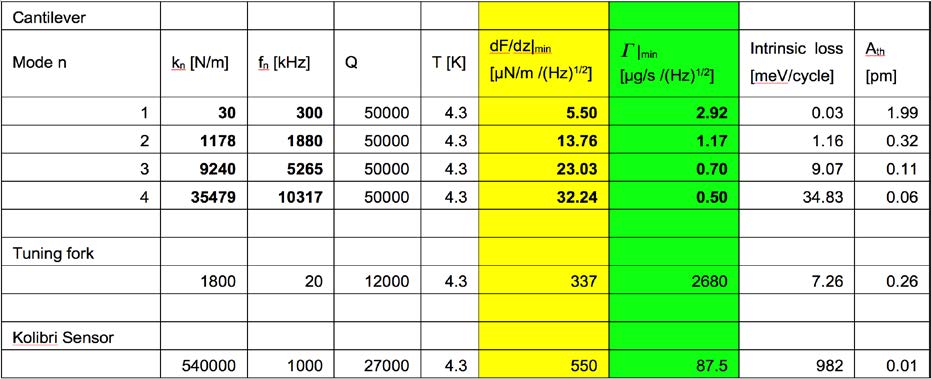Advantages of Cantilever-based Scanning Force Microscopes
Because of their lower mass, microfabricated cantilevers provide an improved sensitivity for force gradients and a tip-sample interaction generated loss of energy from the oscillating cantilever [1] (see table). The high resonance frequency of these cantilevers (in higher modes up to 10 MHz) further facilitates the detection of dissipation signals (green column of table). Microfabricated cantilevers used in atomic resolution AFM work typically have force constants around a few tens of Newtons per Meter. For atomic resolution imaging such cantilevers can be operated with sub-Angstrom oscillation amplitudes if higher flexural oscillation modes are used [2]. The modal stiffness of the cantilever (1178 N/m) is then comparable to that of a tuning fork (1800 N/m, see table). If the first flexural mode is used, larger oscillation amplitudes (typically a few Nanometers) are required for a stable operation of the distance feedback. This is because at small amplitudes the energy stored in the cantilever remains small compared to energy losses that can stochastically occur when the cantilever tip interacts with the sample. The tip-sample distance feedback that typically keeps the resonance frequency shift constant would then fail. In our work we however discovered that stable imaging conditions can be obtained when either the tunneling current or a higher oscillation mode frequency shift is used for the distance feedback. Under these conditions the PLL can track frequency shifts and dissipation signals using the first flexural modes with sub-Angstrom amplitudes. Such small amplitudes match the typical decay length of inter-atomic forces and thus increase the shift of the resonance frequency. Alternatively the first flexural mode does not need to be driven at all but thermal noise spectra can be acquired at each point of the recorded image. Such an operation mode thus makes fully profits from the excellent sensitivity properties of microfabricated cantilevers.

-
Share
